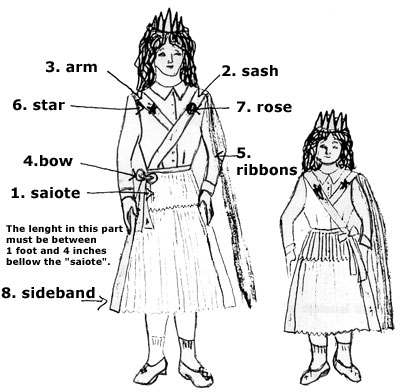
The Fardamento
Yes, the ceremony happened before the beginning of the work. Mestre would give the instructions of how should behave a fardado and then he would call one by one to pin their stars. Sometimes, when there were too many people, he also summoned other fardados to also pin the stars in the new fardados. They started the work already fardados...
Daniel Arcelino Serra - www.afamiliajuramidam.org
Mestre Irineu established the use of uniforms so that the members of the Santo Daime church would be recognized as the Queen of the Forest warriors.
The fardamento is the ceremony of giving the Star to an initiate and of consecration of the ceremonial (preferably white) uniform, making the associate an active member of the Santo Daime under the Imperial Master, Juramidam.
Santo Daime processions require a particular uniform from those individuals that have undergone a specific ceremony called "fardamento" in which their relationship with the doctrine is officially recognized. The uniforms, or "fardas" as they are called, comes in two versions, the white and the blue, and the collective name for members wearing them is "fardados/as". The white farda is used in all major religious processions that are officially registered on the church calendar. These processions include all major Christian holidays, prominent members’ birthdays, and special events such as weddings, baptisms, and those called fardamentos mentioned previously.
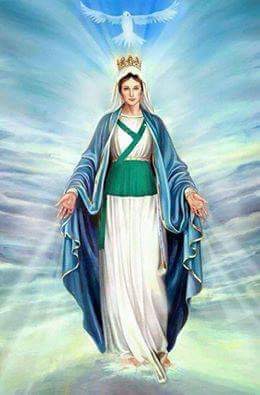
"The brother or sister, in case their time had come, would dress the farda, the star and would enter the salão to dance, don’t you know?"
Percília Matos da Silva - www.juramidam.jor.br
Percília Matos da Silva - www.juramidam.jor.br
O fardamento é o momento onde o aspirante torna-se adepto e membro efetivo da casa, através do ritual que consiste em vestir a farda ritualística e receber a Estrela, insígnia que simboliza seu compromisso com a Doutrina de Juramidam.
O fardamento se reveste de um grande significado simbólico e de iniciação. É fundamental que todo aquele que queira dar esse passo, o faça com liberdade de escolha, sinceridade de propósitos e lealdade no coração. Lembrar que toda a iniciação espiritual, pressupõe uma morte e renascimento.
O fardamento implica numa aceitação dos preceitos crísticos, numa afirmação de fé na doutrina, e num voto de obediência espiritual ao atual comando da casa.
Aquele que assume a responsabilidade de fardar-se, integra o quadro de filiados do ICEFLU, e assume os compromissos que constam na Norma de Ritual, Preceitos Doutrinários e Regulamentos Internos do ICEFLU e do Centro Filiado.
O fardado deve participar de forma sistemática dos trabalhos oficiais, concentrações do calendário oficial, zelando pelo brilho, alegria, disciplina e devoção na execução de nossos rituais.
As condições prévias para o fardamento são :
Ter participado de pelo menos três trabalhos oficiais (incluindo as concentrações)
Ter conhecimento dos princípios doutrinários, éticos e estatutários tanto do centro local, quanto do ICEFLU.
Ser aprovado pela diretoria do centro ao qual se afiliou.
Ser associado do ICEFLU e ao centro local que frequentará
Recomendações aos fardados
Atitude de interiorização, silêncio e concentração nos dias de trabalho
Entrar no salão com uma sincera emoção, devoção e abertura para se transformar
Integrar-se na corrente dos hinos com uma atitude mental de clareza, firmeza e interesse no trabalho, sem medir sacrifícios nem sucumbir ao sono e cansaço.
Resolver suas pendências, animosidades e contendas com outros irmãos.
Estar sempre solícito em dar e receber o perdão antes de começar cada trabalho.
Não se apresentar com a mente trancada por nada, para que possa haver ligação na corrente espiritual e energia mental positiva e amorosa para circular na corrente.
Manter a mente concentrada e interiorizada no canto e no bailado. Não converse na corrente, é o canto dos hinos que deve exteriorizar.
Não divagar na forma de pensamentos, impressões, distrações e fantasias. Todo o emprenho mental deve estar concentrado na afirmação do canto, nas verdades declaradas pelos hinos.
Estar com a mente direcionada para criar o padrão de vibração necessário para a iluminação espiritual e cura de todos.
Estar envolvido com os projetos do centro filiado.
Participar de reuniões, quando convocado
Preparar-se para num período de no máximo seis meses, estar bailando, cantando e tocando seu maracá ao mesmo tempo.
Quando sair da corrente procurar faze-lo pelo período de três hinos e comunicar a saída ao companheiro da direita. Caso haja a necessidade de mais tempo os fiscais deverão ser informados, para preencherem o lugar.
Quando voltar para a corrente, esperar o final do hino que está sendo executado, para depois assumir seu lugar.
Entrar sempre pela frente da fileira e não atravessar o bailado.
Respeitar as orientações dos fiscais e do comando da casa.
Evitar tomar água em grandes quantidades. A água é somente para umedecer a boca, quando está seca.
Procurar se movimentar com suavidade, evitar movimentos bruscos e acelerados
O fardamento se reveste de um grande significado simbólico e de iniciação. É fundamental que todo aquele que queira dar esse passo, o faça com liberdade de escolha, sinceridade de propósitos e lealdade no coração. Lembrar que toda a iniciação espiritual, pressupõe uma morte e renascimento.
O fardamento implica numa aceitação dos preceitos crísticos, numa afirmação de fé na doutrina, e num voto de obediência espiritual ao atual comando da casa.
Aquele que assume a responsabilidade de fardar-se, integra o quadro de filiados do ICEFLU, e assume os compromissos que constam na Norma de Ritual, Preceitos Doutrinários e Regulamentos Internos do ICEFLU e do Centro Filiado.
O fardado deve participar de forma sistemática dos trabalhos oficiais, concentrações do calendário oficial, zelando pelo brilho, alegria, disciplina e devoção na execução de nossos rituais.
As condições prévias para o fardamento são :
Ter participado de pelo menos três trabalhos oficiais (incluindo as concentrações)
Ter conhecimento dos princípios doutrinários, éticos e estatutários tanto do centro local, quanto do ICEFLU.
Ser aprovado pela diretoria do centro ao qual se afiliou.
Ser associado do ICEFLU e ao centro local que frequentará
Recomendações aos fardados
Atitude de interiorização, silêncio e concentração nos dias de trabalho
Entrar no salão com uma sincera emoção, devoção e abertura para se transformar
Integrar-se na corrente dos hinos com uma atitude mental de clareza, firmeza e interesse no trabalho, sem medir sacrifícios nem sucumbir ao sono e cansaço.
Resolver suas pendências, animosidades e contendas com outros irmãos.
Estar sempre solícito em dar e receber o perdão antes de começar cada trabalho.
Não se apresentar com a mente trancada por nada, para que possa haver ligação na corrente espiritual e energia mental positiva e amorosa para circular na corrente.
Manter a mente concentrada e interiorizada no canto e no bailado. Não converse na corrente, é o canto dos hinos que deve exteriorizar.
Não divagar na forma de pensamentos, impressões, distrações e fantasias. Todo o emprenho mental deve estar concentrado na afirmação do canto, nas verdades declaradas pelos hinos.
Estar com a mente direcionada para criar o padrão de vibração necessário para a iluminação espiritual e cura de todos.
Estar envolvido com os projetos do centro filiado.
Participar de reuniões, quando convocado
Preparar-se para num período de no máximo seis meses, estar bailando, cantando e tocando seu maracá ao mesmo tempo.
Quando sair da corrente procurar faze-lo pelo período de três hinos e comunicar a saída ao companheiro da direita. Caso haja a necessidade de mais tempo os fiscais deverão ser informados, para preencherem o lugar.
Quando voltar para a corrente, esperar o final do hino que está sendo executado, para depois assumir seu lugar.
Entrar sempre pela frente da fileira e não atravessar o bailado.
Respeitar as orientações dos fiscais e do comando da casa.
Evitar tomar água em grandes quantidades. A água é somente para umedecer a boca, quando está seca.
Procurar se movimentar com suavidade, evitar movimentos bruscos e acelerados
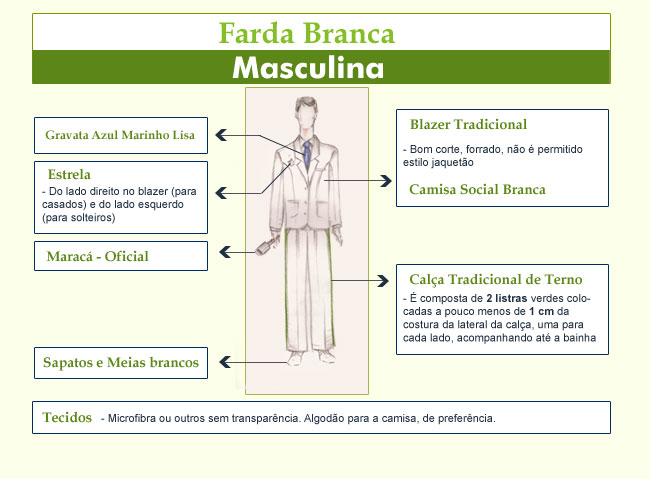
“How did Mestre proceed when some one wanted to become a fardado?”
“He explained that it was a responsibility. 'For what reason the person wanted it', he would ask. Because even to drink the Daime Mestre would ask: 'why do you want to drink the Daime; do you know what the Daime is?' It would even 'frighten the person'. He would say: 'Look, you are going to get yourself into a very serious thing; is this what you want? It is a great responsibility'. It applies the same for the fardamento. It is not for everyone. Sometimes he would say: 'Give it some time, you have to know this service better, to know if it is worthwhile'. He did not like anything to be forced; not at all. This decision had to come from the heart… to say 'you have to get your farda, to stay here', negative! I never saw him do that. There were some people that I think lived their entire life here and never became fardados. Sometimes he would see someone that he thought could develop into something else and he would say: 'Look, you are ready to get your farda', but it had times that it was better to stay without the farda, really".
Daniel Arcelino Serra - www.juramidam.jor.br
“He explained that it was a responsibility. 'For what reason the person wanted it', he would ask. Because even to drink the Daime Mestre would ask: 'why do you want to drink the Daime; do you know what the Daime is?' It would even 'frighten the person'. He would say: 'Look, you are going to get yourself into a very serious thing; is this what you want? It is a great responsibility'. It applies the same for the fardamento. It is not for everyone. Sometimes he would say: 'Give it some time, you have to know this service better, to know if it is worthwhile'. He did not like anything to be forced; not at all. This decision had to come from the heart… to say 'you have to get your farda, to stay here', negative! I never saw him do that. There were some people that I think lived their entire life here and never became fardados. Sometimes he would see someone that he thought could develop into something else and he would say: 'Look, you are ready to get your farda', but it had times that it was better to stay without the farda, really".
Daniel Arcelino Serra - www.juramidam.jor.br
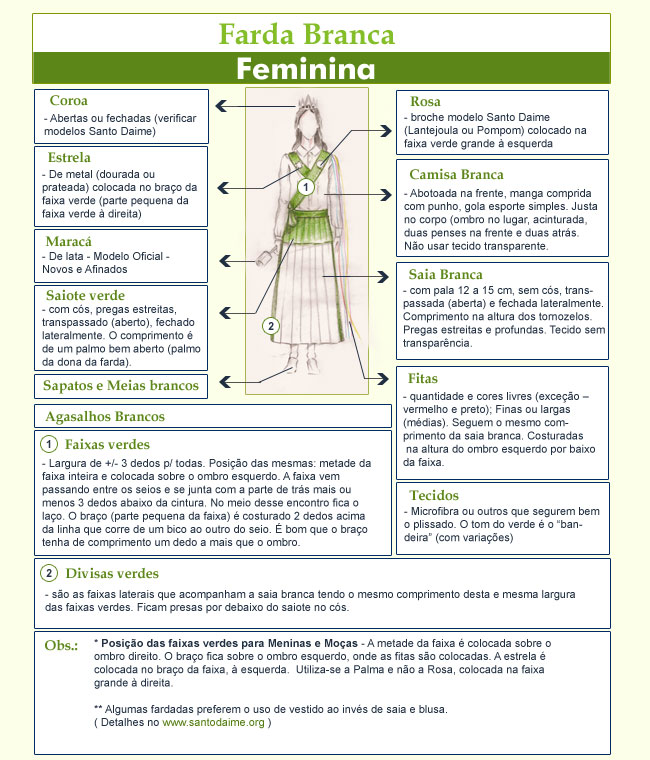
"When I arrived in Rio Branco, on February 14th of 1957, there were few fardados, gathering the most thirty on occasion. After a time I felt the wish to get my farda, but he, Mestre, thought that it wasn't the moment and when the moment was right he would tell me. Two years later I became a fardado. In that time you could only get your farda in two dates: the day of Saint John (6/24) and the day of the Virgin of the Conception (12/08), where always more than one person would get their farda. They had to wait for these dates. The maraca, which was the first instrument that he received from the Queen, was the following; it had a rehearsal for people who wanted to learn. There are people who want to take the maraca off the works and this is wrong.
Mestre once in a while also taught the steps of the danced ritual. These rehearsals were without farda. In the fardamento he would give instructions, saying that the fardados had to form a current always with the positive thoughts. The one that did it with more care would pass to the line in front, soon becoming a support person, independently of seniority.
He also told how behaved the fardado in the everyday life. One has to have a respect and love behavior towards the fellow brothers and sisters. This is how Mestre began. It was after that the official farda came, but I don't recall when. The first hymn sung with the official uniform was his. In this time there were a few Hinários. The only ones who had it were Germano Guilherme, João Pereira, Maria Damião, Antônio Gomes and later on other people like Raimundo Gomes. After these dates more hymns started to appear".
Daniel Arcelino Serra - www.afamiliajuramidam.org
Mestre once in a while also taught the steps of the danced ritual. These rehearsals were without farda. In the fardamento he would give instructions, saying that the fardados had to form a current always with the positive thoughts. The one that did it with more care would pass to the line in front, soon becoming a support person, independently of seniority.
He also told how behaved the fardado in the everyday life. One has to have a respect and love behavior towards the fellow brothers and sisters. This is how Mestre began. It was after that the official farda came, but I don't recall when. The first hymn sung with the official uniform was his. In this time there were a few Hinários. The only ones who had it were Germano Guilherme, João Pereira, Maria Damião, Antônio Gomes and later on other people like Raimundo Gomes. After these dates more hymns started to appear".
Daniel Arcelino Serra - www.afamiliajuramidam.org
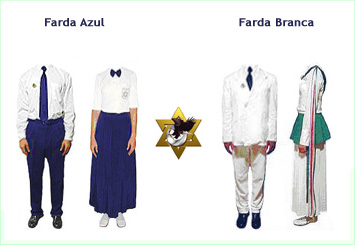
Farda Branca (White Uniform)
The white uniform consists of an all-white suit for male members, a white dress shirt,
black tie, and shoes which can range in style but more often than not serving comfort over style due to the amount of time spent standing. Pinned to the right side of the jacket is the official Santo Daime metal brooch. The emblem is in the shape of the hexagonal star with an eagle and a crescent moon. According to an interview I conducted in the Virgem da Luz parish, the symbols depicted are representative of an event described by Raimundo Irineu Serra in which, having spent a considerable amount of days in the jungle alone consuming ayahuasca, he witnessed an eagle flying toward the moon. The Portuguese words for eagle and moon are Agia and Lua respectively, however the word Agia resembles the phrase "A Guia" which means “a guide”.92 Thus the conclusion reached by Raimundo Irineu Serra was that the symbolism represents the moon as being a guide.
The farda used by female members consists of an ankle-long green pleated skirt, white blouse, black bow tie, and a green sash draped from a particular shoulder to the waist, depending on the age and marital status of the individual member; if the woman is married, the sash drapes from the left shoulder down to the right side of the waist. The women also wear their hair down dawning a silver colored tiara and the Santo Daime badge. The "why" as relating to the specifics of the fardas are largely arbitrary creations of one women closely related to Raimundo Irineu Serra who is principally responsible for creating and standardizing the ritual space.
The white uniform consists of an all-white suit for male members, a white dress shirt,
black tie, and shoes which can range in style but more often than not serving comfort over style due to the amount of time spent standing. Pinned to the right side of the jacket is the official Santo Daime metal brooch. The emblem is in the shape of the hexagonal star with an eagle and a crescent moon. According to an interview I conducted in the Virgem da Luz parish, the symbols depicted are representative of an event described by Raimundo Irineu Serra in which, having spent a considerable amount of days in the jungle alone consuming ayahuasca, he witnessed an eagle flying toward the moon. The Portuguese words for eagle and moon are Agia and Lua respectively, however the word Agia resembles the phrase "A Guia" which means “a guide”.92 Thus the conclusion reached by Raimundo Irineu Serra was that the symbolism represents the moon as being a guide.
The farda used by female members consists of an ankle-long green pleated skirt, white blouse, black bow tie, and a green sash draped from a particular shoulder to the waist, depending on the age and marital status of the individual member; if the woman is married, the sash drapes from the left shoulder down to the right side of the waist. The women also wear their hair down dawning a silver colored tiara and the Santo Daime badge. The "why" as relating to the specifics of the fardas are largely arbitrary creations of one women closely related to Raimundo Irineu Serra who is principally responsible for creating and standardizing the ritual space.
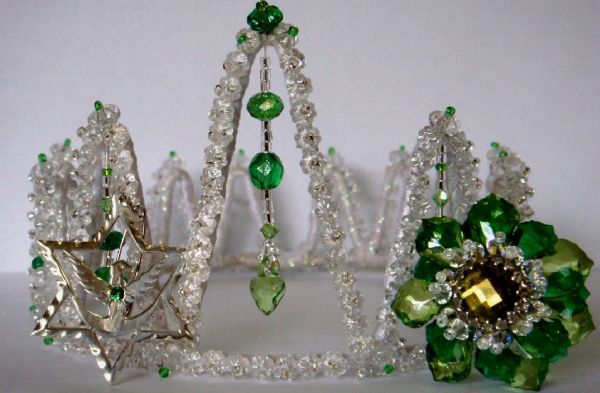
Farda Azul (The Blue Uniform)
The blue farda is the second type of recognized Santo Daime uniform which is used
during concentration works that regularly take place twice per month, typically on the 15th and 30th, as well as for most special works that take place outside of the physical church space. It consists of navy blue pants and tie along with a white shirt without a coat for men, and a navy blue ankle skirt, white short-sleeved blouse and navy blue bow tie for women. The color black and red in attire are specifically forbidden the reasons for which was never adequately provided to me. Visitors who are not fardado members can wear what they please so long as it is appropriate and light in color. Body temperature fluctuates wildly due to the effects of ayahuasca, from perfuse sweating to uncontrollable shivering, thus most participants will have a sweater or shall to cover up with which can be of any style, and there are always blankets located on the benches by the walls to be used by anyone who needs them. There were two special instances I observed regarding attire which have been previously mentioned: in one recent ceremony conducted in the Los Angeles parish, one Jewish man wore the traditional Kippah, Tallit, and Tefillin, and at the conclusion of a long ceremony in Céu do Mapiá, one of the village elders and a daughter of Sebastião Mota de Melo vehemently and in front of all present scolded a teenage boy, who was not a resident of the community, for wearing jeans and a t-shirt with an image of a scantily clad woman printed on the front, to which the young man reacted by promptly storming off into the night in anger and shame.
The blue farda is the second type of recognized Santo Daime uniform which is used
during concentration works that regularly take place twice per month, typically on the 15th and 30th, as well as for most special works that take place outside of the physical church space. It consists of navy blue pants and tie along with a white shirt without a coat for men, and a navy blue ankle skirt, white short-sleeved blouse and navy blue bow tie for women. The color black and red in attire are specifically forbidden the reasons for which was never adequately provided to me. Visitors who are not fardado members can wear what they please so long as it is appropriate and light in color. Body temperature fluctuates wildly due to the effects of ayahuasca, from perfuse sweating to uncontrollable shivering, thus most participants will have a sweater or shall to cover up with which can be of any style, and there are always blankets located on the benches by the walls to be used by anyone who needs them. There were two special instances I observed regarding attire which have been previously mentioned: in one recent ceremony conducted in the Los Angeles parish, one Jewish man wore the traditional Kippah, Tallit, and Tefillin, and at the conclusion of a long ceremony in Céu do Mapiá, one of the village elders and a daughter of Sebastião Mota de Melo vehemently and in front of all present scolded a teenage boy, who was not a resident of the community, for wearing jeans and a t-shirt with an image of a scantily clad woman printed on the front, to which the young man reacted by promptly storming off into the night in anger and shame.
A farda foi recebida por Mestre Irineu, através de mensagens da Rainha da Floresta, e deve ser vista como o paramento para entrar no mundo espiritual.
"Em 1957, o Mestre fez uma viagem até o Maranhão, onde passou dois dias e duas noites no mar, mirando muito. Foi nessa viagem que ele recebeu o novo tipo de farda, usada até hoje. Os homens usavam as fitinhas coloridas que as mulheres ainda usam e uma rosa grande. O distintivo era aquela rosa. Depois foi que ele mudou para a estrela de seis pontas"
(RELATO: PERCÍLIA MATOS DA SILVA)-http://www.mestreirineu.org/percilia.htm
'As fardas brancas são utilizadas em dias de Hinário Oficial (calendário) . As cores referem-se à Bandeira Nacional : o verde a esperança e nossas matas; o branco da pureza, o azul do céu e do manto da Nossa Senhora da conceição. As fardas azuis são para trabalhos de concentração, cura e não oficiais.
As fitas coloridas da farda feminina evocam a miração e as energias de alegria, e são pregadas no ombro esquerdo.
A faixa que atravessa o peito diagonalmente, simboliza proteção contra forças negativas. O correspondente na farda masculina é a gravata azul.
A coroa é a ligação com o astral, o chacra da coroa, simboliza a ligação com as esferas superiores, e como representantes da Rainha da Floresta as mulheres são coroadas.
A farda branca masculina é composta de uma calça branca com friso verde, camisa e paletó branco e gravata azul marinho.
A farda azul para mulher é a saia azul, camisa branca e gravata borboleta azul. Na camisa, há um bolso no lado esquerdo onde está pintada a sigla CRF ( Centro de Regeneração e Fé ( nome do primeiro ponto do Mestre), também com a estrela de seis pontas, a águia e a lua. Para os homens a farda é composta pela calça azul, camisa branca e gravata azul.
A ESTRELA
O fardado recebe a estrela no momento do seu fardamento. A estrela é de seis pontas, o símbolo do Rei Salomão. Nela ainda a Lua simbolizando a Rainha da Floresta e da Águia, a ave que voa mais alto, símbolo da visão ilimitada e da nobreza, voando acima das nuvens negras da ignorância. Os casados (as) a usam do lado direito do peito, os solteiros (as) do lado esquerdo.
"Em 1957, o Mestre fez uma viagem até o Maranhão, onde passou dois dias e duas noites no mar, mirando muito. Foi nessa viagem que ele recebeu o novo tipo de farda, usada até hoje. Os homens usavam as fitinhas coloridas que as mulheres ainda usam e uma rosa grande. O distintivo era aquela rosa. Depois foi que ele mudou para a estrela de seis pontas"
(RELATO: PERCÍLIA MATOS DA SILVA)-http://www.mestreirineu.org/percilia.htm
'As fardas brancas são utilizadas em dias de Hinário Oficial (calendário) . As cores referem-se à Bandeira Nacional : o verde a esperança e nossas matas; o branco da pureza, o azul do céu e do manto da Nossa Senhora da conceição. As fardas azuis são para trabalhos de concentração, cura e não oficiais.
As fitas coloridas da farda feminina evocam a miração e as energias de alegria, e são pregadas no ombro esquerdo.
A faixa que atravessa o peito diagonalmente, simboliza proteção contra forças negativas. O correspondente na farda masculina é a gravata azul.
A coroa é a ligação com o astral, o chacra da coroa, simboliza a ligação com as esferas superiores, e como representantes da Rainha da Floresta as mulheres são coroadas.
A farda branca masculina é composta de uma calça branca com friso verde, camisa e paletó branco e gravata azul marinho.
A farda azul para mulher é a saia azul, camisa branca e gravata borboleta azul. Na camisa, há um bolso no lado esquerdo onde está pintada a sigla CRF ( Centro de Regeneração e Fé ( nome do primeiro ponto do Mestre), também com a estrela de seis pontas, a águia e a lua. Para os homens a farda é composta pela calça azul, camisa branca e gravata azul.
A ESTRELA
O fardado recebe a estrela no momento do seu fardamento. A estrela é de seis pontas, o símbolo do Rei Salomão. Nela ainda a Lua simbolizando a Rainha da Floresta e da Águia, a ave que voa mais alto, símbolo da visão ilimitada e da nobreza, voando acima das nuvens negras da ignorância. Os casados (as) a usam do lado direito do peito, os solteiros (as) do lado esquerdo.
The History and Evolution of Uniforms
The Santo Daime tradition has two uniforms, the blue uniform for Works of Concentration, Healing and the Mass, and the white uniform for Official Works, festival, celebratory or memorial dancing Works which are held on specific days of the Santo Daime Calendar.
There are various sources that describe the history of the development and adaptation of the uniforms worn in the Santo Daime religion. It is considered that the introduction of the white uniform began in 1936. Numerous changes were made in the ensuing years, as various decorative elements were added, changed or removed over time.
Mestre Irineu, born in 1890, came from the region of Maranhão and some researchers suggest that aspects of the religious and cultural traditions of the region can be found in the Santo Daime. In particular, the customs and rituals of Saint Gonçalo contain strong resemblances in dance, uniform, music as well in the structure of the ritual buildings. It is suggested that these influences played a role in the early development of the rituals, music and uniforms of the Santo Daime. Mestre Irineu’s Catholic upbringing is reflected in the Santo Daime, as are the Native beliefs and Spiritism experiences he had in his apprenticeship with Peruvian Ayahuasqueiros.
After leaving Maranhão at a young age, Mestre did not return until 1957. It is striking to note that after his visit, more changes were made in the White uniform adding elements including a sash, colourful ribbons and a rose, making it even more similar to traditional Saint Gonçalo uniforms. For example – the crown worn by the women in the rituals of the Santo Daime are very similar to the ones of Saint Gonçalo. Later, some of the additions or costume elements were removed – but only from the men’s uniforms. In time the rose was changed for the six-pointed Star similar to the one worn today.
The blue uniform was instituted in 1972; the year after Mestre Irineu’s passage. According to various sources, before his death Mestre Irineu asked that there be adopted another uniform for the days of the Works other than the white uniform. In the beginning of 1972 the blue uniform was instituted for the concentrations, the Holy Mass and unofficial hinários.
In 1997, after one year of apprenticeship in the Santo Daime, I felt called to take my Star, and make the full commitment to the Santo Daime path. This calling was confirmed one evening in a Work as the Star came to me in a vision, divided into two Stars, and one Star took up residence in the middle of my forehead and the other over my heart. As the miração continued I could see myself, as if from another vantage point. While in actuality I was wearing simple, all white clothing, I could see myself wearing a white pleated skirt, a white long-sleeved blouse and a green sash around my waist, with the Star pinned over my heart. I kept this vision in my heart, wondering why I had been given it, as the woman’s uniform that I was about to put on was much more decorated and complicated.
From its official founding in 1997 until 2010, Céu do Montréal wore the traditional white and blue uniforms in all rituals. In 2010, upon choosing independent status, and while redefining its Mission Statement and reviewing policies, Céu do Montréal members took into consideration the uniforms of the rituals. After considerable prayer and discussion the following decisions were made. The blue uniform would remain the same for both women and men, with the exception that the crest on the pocket of the woman’s blouse could be replaced by the Star, thus bringing the women’s uniform into alignment with the men’s.
The men’s white uniform remains the same, however without the green stripe on the side of the men’s trousers.
The women’s white uniform has undergone the most change. It was taken into consideration that many of the elements that had been on the men’s uniform had been removed, such as trailing coloured ribbons (known as alegrias), and green sashes. It was decided – with the unanimous consent of the members, that the woman’s uniform be a more simple and practical one that would respect the lineage, be in alignment with the simplicity of the men’s white uniform, and also be more in harmony with Canadian culture. Twenty years later, the vision regarding the women’s white uniform that I had the night the Star came to me, is now a reality.
The women’s white uniform of Céu do Montréal keeps the basic white uniform: the white long-sleeved blouse, the pleated white skirt, and has a green sash at the waist and a green bow-tie. All other costume elements, including the crown, have been removed.
The Star is worn in the traditional place on both the men’s and women’s blue and white uniforms.
The Santo Daime tradition has two uniforms, the blue uniform for Works of Concentration, Healing and the Mass, and the white uniform for Official Works, festival, celebratory or memorial dancing Works which are held on specific days of the Santo Daime Calendar.
There are various sources that describe the history of the development and adaptation of the uniforms worn in the Santo Daime religion. It is considered that the introduction of the white uniform began in 1936. Numerous changes were made in the ensuing years, as various decorative elements were added, changed or removed over time.
Mestre Irineu, born in 1890, came from the region of Maranhão and some researchers suggest that aspects of the religious and cultural traditions of the region can be found in the Santo Daime. In particular, the customs and rituals of Saint Gonçalo contain strong resemblances in dance, uniform, music as well in the structure of the ritual buildings. It is suggested that these influences played a role in the early development of the rituals, music and uniforms of the Santo Daime. Mestre Irineu’s Catholic upbringing is reflected in the Santo Daime, as are the Native beliefs and Spiritism experiences he had in his apprenticeship with Peruvian Ayahuasqueiros.
After leaving Maranhão at a young age, Mestre did not return until 1957. It is striking to note that after his visit, more changes were made in the White uniform adding elements including a sash, colourful ribbons and a rose, making it even more similar to traditional Saint Gonçalo uniforms. For example – the crown worn by the women in the rituals of the Santo Daime are very similar to the ones of Saint Gonçalo. Later, some of the additions or costume elements were removed – but only from the men’s uniforms. In time the rose was changed for the six-pointed Star similar to the one worn today.
The blue uniform was instituted in 1972; the year after Mestre Irineu’s passage. According to various sources, before his death Mestre Irineu asked that there be adopted another uniform for the days of the Works other than the white uniform. In the beginning of 1972 the blue uniform was instituted for the concentrations, the Holy Mass and unofficial hinários.
In 1997, after one year of apprenticeship in the Santo Daime, I felt called to take my Star, and make the full commitment to the Santo Daime path. This calling was confirmed one evening in a Work as the Star came to me in a vision, divided into two Stars, and one Star took up residence in the middle of my forehead and the other over my heart. As the miração continued I could see myself, as if from another vantage point. While in actuality I was wearing simple, all white clothing, I could see myself wearing a white pleated skirt, a white long-sleeved blouse and a green sash around my waist, with the Star pinned over my heart. I kept this vision in my heart, wondering why I had been given it, as the woman’s uniform that I was about to put on was much more decorated and complicated.
From its official founding in 1997 until 2010, Céu do Montréal wore the traditional white and blue uniforms in all rituals. In 2010, upon choosing independent status, and while redefining its Mission Statement and reviewing policies, Céu do Montréal members took into consideration the uniforms of the rituals. After considerable prayer and discussion the following decisions were made. The blue uniform would remain the same for both women and men, with the exception that the crest on the pocket of the woman’s blouse could be replaced by the Star, thus bringing the women’s uniform into alignment with the men’s.
The men’s white uniform remains the same, however without the green stripe on the side of the men’s trousers.
The women’s white uniform has undergone the most change. It was taken into consideration that many of the elements that had been on the men’s uniform had been removed, such as trailing coloured ribbons (known as alegrias), and green sashes. It was decided – with the unanimous consent of the members, that the woman’s uniform be a more simple and practical one that would respect the lineage, be in alignment with the simplicity of the men’s white uniform, and also be more in harmony with Canadian culture. Twenty years later, the vision regarding the women’s white uniform that I had the night the Star came to me, is now a reality.
The women’s white uniform of Céu do Montréal keeps the basic white uniform: the white long-sleeved blouse, the pleated white skirt, and has a green sash at the waist and a green bow-tie. All other costume elements, including the crown, have been removed.
The Star is worn in the traditional place on both the men’s and women’s blue and white uniforms.
